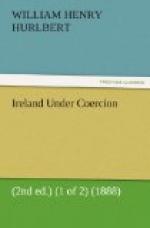“What was done with it, then?”
“Oh! that I can’t tell ye. It was spent for the people some way. You must ask Father M’Fadden. He is the fund in Gweedore, just as he is the law in Gweedore. Oh! they came from all parts to see the great ruin of the flood at Gweedore. They did, indeed. And some of them, it was poor sight they had; they couldn’t see the big rift in the walls, when Father M’Fadden pointed it out to them. ‘Whisht! there it is!’ he would say, pointing with his finger. Then they saw it!”
I asked him at what figure he put the income of Father M’Fadden from his parish. Without a moment’s hesitation he answered, “It’s over a thousand pounds a year, sir, and nearer twelve hundred than eleven.” I expressed my surprise at this, the whole rental of Captain Hill, the landlord, falling, as I had understood, below rather than above L700 a year; and Gweedore, as Father Walker had told me, containing fewer houses than Burtonport.
“Fewer houses, mayhap,” said the sergeant, “though I’m not sure of that; but if fewer they pay more. There’s but one curate—poor man, he does all the parish work, barring the high masses, and a good man he is, but he gets L400 a year, and that is but a third of the income!”
I asked by what special stipends the priest’s income at Gweedore could be thus enhanced. “Oh, it’s mainly the funeral-money that helps it up,” he replied. “You see, sir, since Father M’Fadden came to Gweedore it’s come to be the fashion.”
“The fashion?” I said.
“Yes, sir, the fashion. This is the way it is, you see. When a poor creature comes to be buried—no matter who it is, a pauper, or a tenant, or any one—the people all go to the chapel; and every man he walks up and lays his offering for the priest on the coffin; and the others, they watch him. And, you see, if a man that thinks a good deal of himself walks up and puts down five shillings, why, another man that thinks less of him, and more of himself, he’ll go up and make it a gold ten-shilling piece, or perhaps even a sovereign! I’ve known Father M’Fadden, sir, to take in as much as L15 in a week in that way.”
Sergeant Mahony told us a curious tale, too, of the way in which Father M’Fadden dealt with the people of the neighbouring parish of Falcarragh. He would go down to the parish boundary, if he wanted to address the people of Falcarragh, and stand over the line, with one foot in each parish!
At our request Sergeant Mahony made some remarks in Irish; very wooing and winning they were in sound. Before he left Baron’s Court he promised to make out and send me a schedule of the parochial income at Gweedore, under the separate heads of the sources whence it is derived.
Obviously Sergeant Mahony would make a good “devil’s advocate” at the canonization of Father M’Fadden. But, all allowances made for this, one thing would seem to be tolerably clear. Of the three personages who take tribute of the people of Gweedore, the law intervenes in their behalf with only one—the landlord. The priest and the “Gombeen man” deal with them on the old principle of “freedom of contract.” But it is by no means so clear which of the three exacts and receives the greatest tribute.




